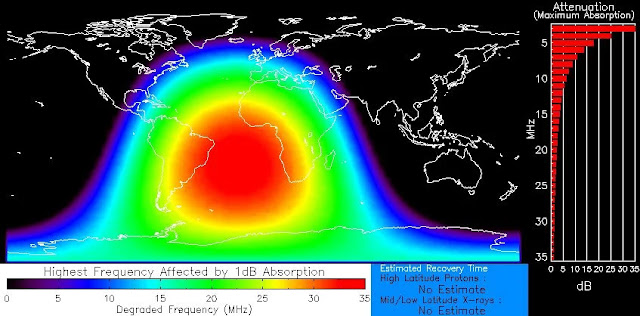NASA - Solar Dynamics Observatory (SDO) patch.
July 10, 2021
The strength of a solar flare recorded on July 3 led to an interruption in short-wave radio communication over the Atlantic Ocean. The flare was the first to be identified as an X-ray pulse in the new solar cycle 25, affecting the upper end of the Earth's atmosphere.
X flares are the strongest type of solar flare. They are generally responsible for the deepest radio blackouts and the most intense geomagnetic storms. According to a NASA statement, at the time of registering the eruption the solar material reached a temperature of approximately 5 million and a half degrees Celsius.
Image above provided by the Atmospheric Imaging Assembly / channel 94 Angstrom telescope, showing solar material at approximately 5.5 million degrees Celsius on July 3, during the eruption that led to solar flare X. Image Credits: NASA/SDO.
Generally speaking, a solar flare is an explosion on the Sun that occurs when stored energy is suddenly released. Flares produce a burst of radiation across the entire electromagnetic spectrum, from radio waves to X-rays and gamma rays.
Such an extreme release of energy can be felt here on Earth, even though the Sun is more than 150 million kilometers away from our planet. To get an idea of the magnitude of the energy released, it can be taken into account that a solar flare X is equivalent to millions of 100 megaton hydrogen bombs exploding at the same time.
Flares and solar cycles
Scientists have established a classification of solar flares according to the intensity measured in X-rays, in a wavelength range of 1 to 8 Angstroms. Within the three existing classifications, solar X flares are the strongest: they can trigger radio blackouts across the planet and long-lasting radiation storms.
The intensity of solar flares is related to solar cycles, since some have a greater quantity and strength in the eruptions. Likewise, within solar cycles there are periods of greater or lesser activity.
X-rays and ultraviolet radiation from the solar flare ionized the upper part of Earth's atmosphere, producing a short-wave radio blackout over the South Atlantic last year (2020), as can be seen in the following map (Credits: NASA/SDO):
To understand these cycles, it must be considered that the Sun, a huge sphere of hot gas with an electric charge, has an intense magnetic field generated by the movement of said gas. The solar magnetic field goes through different changes, which are evidenced every 11 years with the advent of a new solar cycle.
Solar cycles affect the activity on the surface of the Sun: these variations are observed in the form of sunspots. During the so-called solar minimum, which occurs at the beginning of each cycle, the sun king has less activity. But about half of each cycle, solar maximum is recorded, a period in which activity increases and a greater number of sunspots are seen.
What awaits us during solar cycle 25?
The quantity and magnitude of sunspots are some of the factors that determine the irruption of phenomena such as the last flare X. In a conventional solar cycle, around 150 flares can be expected to reach the strength of the flare recorded on July 3 . However, around 1,500 less intense flares can occur during the same period.
Sequence in x-rays of the solar flare of category M4.4. Animation Credits NASA/SDO
We are currently initiating solar cycle 25, but during the previous cycle the Sun generated 49 solar X flares, according to an article published by CNN. Estimates around solar cycle 25 indicate that a similar number of X flares can be expected as during the previous cycle.
Therefore, the Earth will have to prepare to withstand several dozen of these extreme events in the coming years, which can put global communications in jeopardy. Around the year 2025 we will reach the solar maximum of this cycle, therefore it is possible that a greater number of intense events will be recorded.
Related links:
NASA release: https://blogs.nasa.gov/solarcycle25/2021/07/03/significant-solar-flare-erupts-from-sun/
Solar Dynamics Observatory (SDO): https://sdo.gsfc.nasa.gov/ and
https://www.nasa.gov/mission_pages/sdo/main/index.html
NOAA’s Space Weather Prediction Center at http://spaceweather.gov
Images, (mentioned), Anomation (mentioned), Text, Credits: NASA/SDO/Orbiter.ch Aerospace/Roland Berga.
Greetings, Orbiter.ch




